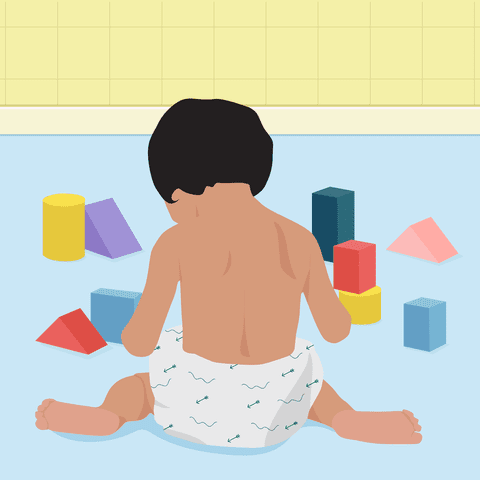Is the 'W' Sitting Position Safe? Experts Weigh In

If you've ever worried about the way your child is sitting, read this before you try to change the way they sit.
Many people with little kids have gotten advice or seen social media stories about the potential dangers of allowing kids to sit in the 'W' position rather than having their legs out in front of them in another way. For this reason, many new parents wonder if it's safe to let their little ones sit this way. The worry is that this sitting position could cause hip dysplasia or other problems with a child's physical development.
However, while it's very common for parents to be told to discourage this way of sitting, research does not back up this concern. In fact, a 2020 study found no difference in rates of hip dysplasia between children who used the "W" sitting position and those who did not. Essentially, most experts say that the idea that sitting in the "W" position can cause postural, orthopedic, or muscular problems down the line is a myth.
Learn more about the "W" sitting position, what it means if your child favors this position, and when to contact their pediatrician.
Related: 11 Activities to Improve Your Toddler's Development
What Is the 'W' Position?
The "W" position is a way some children sit. It might remind you of the hero pose in yoga. More or less, it's a position where a child's bum is on the ground and their legs and knees are in front of them splayed out to the sides with their feet at their hips. The legs make a "W" shape. As babies learn to sit, many go through a phase of sitting in this position.
This position is most commonly seen in toddlers, though some kids sit in this position until eight or nine. Children often sit in a variety of positions, such as cross-legged, legs straight out, or legs bent into a diamond or butterfly shape. One reason some kids may settle into the "W" shape is anatomical. It's common for children to be born with their femurs (or thigh bones) slightly turned in, a condition called femoral anteversion. This makes sitting in a "W" position more comfortable.
"The reality is that most of us have femoral anteversion—it's excessive femoral anteversion that allows kids to sit in the 'W' position," says Greg Hahn, MD, a pediatric orthopaedist at Johns Hopkins All Children's Hospital in St Petersburg, Florida. Typically, femoral anteversion, "W" sitting, in-toeing, and other postural and gait issues lessen as children grow and they will develop normally. If not, your child's pediatrician can refer your child for appropriate treatment.
Related: Toddler Milestones 12-17 Months

Where Do Fears About 'W' Sitting Come From?
Old-school thinking among orthopedists in the 1960s and 1970s warned that in-toeing, or having your toes point inward when you walk, was a muscular or soft tissue issue—and that it was possible to train kids not to do it, explains Dr. Hahn. By having kids avoid positions like the "W" sitting position, the thinking was that you'd avoid stretching out the muscles, which was what was allowing them to continue to in-toe.
However, mounting research, notably beginning in the 1980s by pediatric orthopedist Lynn Staheli, MD, found that in-toeing was simply a normal variation (much like being tall or left-handed) and nothing to worry about. Additionally, most often, this issue self-resolves without any treatment required (read: a changing of position or braces).
Plus, if you watch people walk, you'll notice most don't do so in a perfect, straight-ahead line. Instead, most people toe in or out a bit, and in children, it's just more pronounced, says Dr. Hahn. Even if your child noticeably walks with their toes in, their gait will become straighter as they age.
Related: When Will My Baby Start Walking?
The True Effects of the 'W' Position
In short, while the myth that you have to avoid the 'W' position might live on, Dr. Hahn says that "the position doesn't cause any long-term problems so we don't worry about it." Essentially, it's very common for children to sit in this position, and it won't cause them any harm.
Dr. Hahn also notes that he's unaware of any study linking the position to osteoarthritis issues.
Furthermore, "research by the International Hip Dysplasia Institute and others has shown that increased femoral anteversion does not cause hip dislocations and does not harm the hip socket," says Charles T "Chad" Price, MD, a pediatric orthopedist and medical director of the International Hip Dysplasia Institute.
Dr. Price adds that if children do have femoral anteversion, "W" sitting can be more comfortable and should be allowed. "Spontaneous correction occurs with growth in almost all cases." While in-toeing is very common in young children, it's rarely seen in adults regardless of sitting habits, he says.
When to Consult a Doctor
Most of the time, in-toeing and "W" sitting go away on their own. If this does not happen by elementary school age or your child's gait is particularly off-kilter, check in with their pediatrician for guidance.
Key Takeaways
There is no need to tell your child to change positions if you see them sitting in the 'W' position.
"It's no different than having a kid sit 'criss-cross applesauce'. It's not a problem. It's not bad posture where you have to encourage a kid not to sit that way,'" says Dr. Hahn.
Related: Walking Worries: Common Concerns About Kids Walking
For more Parents news, make sure to sign up for our newsletter!
Read the original article on Parents.

